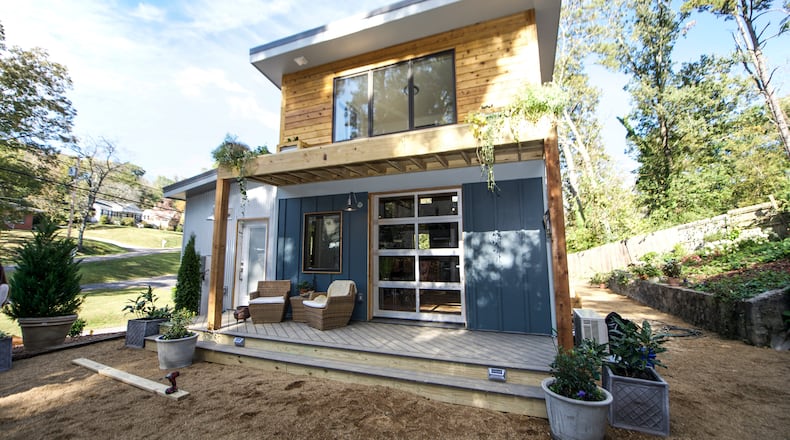The local tiny house movement is going to be big, local experts say: just wait.
"I think you are going to see an explosion of this," said Lew Oliver, an Atlanta architect who designed The Nest cottages, a group of 900- to 1,500-square-foot homes in the Serenbe community in Chattahoochee Hills.
"There's quite a bit of tiny house activity going on in Georgia and the Southeast region," added Zack Giffin, co-host of the FYI show "Tiny House Nation."
By definition, a tiny house is less than 500 square feet, and most are smaller than 200 square feet. They have become predominantly popular with two groups: the young (new homeowners; millennials) and the old (retirees).
Both groups are attracted by the ease.
The majority of tiny houses are DIY projects, built by their owners, with plans and resources provided by companies like the Tiny Home Builders in Cumming. The project can cost less than $20,000, said owner Dan Louche.
"There is nothing much more gratifying than going out and building a house from scratch, and it is something that's doable," he said.
Types of homeowners
Today's generation of young adults, many saddled with student debt after college, generally aren't seeking a suburban mega-mansion, said Oliver the architect. They want to live close to cities, without the complementary mortgage.
"These micro-houses are perfect for them entering the home-buying market for the first time because they are the right price and they are really the right size," Oliver said.
But 51 percent of tiny house owners are over the age of 50, according to thetinylife.com. Not only are tiny houses an economical way to downsize, they also require much less time to maintain.
As such, they offer an alternative to independent senior living facilities.
"Between the millennials and the empty nesters, they are going to drive the creation of these communities," Oliver said.
Legal issues
Most tiny houses are built on trailers and registered as recreational vehicles in order to bypass zoning laws. The only issue for these tiny homes is finding a place to legally park them. Many RV parks are beginning to allow tiny homes, but most are not open year-round or they allocate a maximum time someone can park there.
Another option is putting the tiny house in a backyard of a regularly sized home, but even that comes with restrictions: For tiny houses on wheels, the area must be zoned to allow full-time camping, and most places allow only a maximum of 30 days.
For a tiny house on a foundation, the house has to comply with building codes and usually must be at least 700 square feet, according to the applicable state and city codes.
"I think in urban environments, the biggest challenge is working through zone violations and municipalities," Giffin says. "I think in rural environments, there are fewer restrictions because there's more space so people are more comfortable with unique situations."
As such, rural areas are seeing the largest and fastest growth in tiny home ownership.
"The code enforcement is driven by complaints, and so if you are on rural land, it is very unlikely that someone is going to complain about you," Louche said. "You can put [tiny houses] in a lot of places. You just can't live in it.
"What people do is just park them some place and say they are not living in them and then see how long they can get away with that."
The future of tiny houses in Georgia
More than 80 percent of U.S. residents live in urban areas, according to a Savannah College of Art and Design study, so establishing tiny houses inside the Perimeter is a goal for Will Johnston, leader of the advocacy group Tiny House Atlanta.
One idea is to create micro-condos in unused or abandoned buildings, similar to the SCADPads in Atlanta, which saw SCAD students and faculty transform a vacant parking garage into a vibrant and sustainable living community with four homes measuring 128 square feet each, complete with common areas and a public garden.
Johnston has his eye on another parking deck suitable to be retrofitted into a viable housing space.
"I have never seen a car on its roof," he said. "It just sits there empty all the time, unless there is a Georgia Tech football game."
Another idea he said is to connect with land trusts and the Atlanta Beltline to obtain temporary land to test a tiny house community as either a small residential area or a tiny house hotel, similar to Caravan in Portland, Oregon
As these communities grow, tiny house experts say homeowners actually see their burdens disappear.
"When humans are put in a space, they will fill it," Louche said. "When you get away from that and remove yourself from that consumerist lifestyle, people are literally liberated."
Keep Reading
The Latest
Featured


